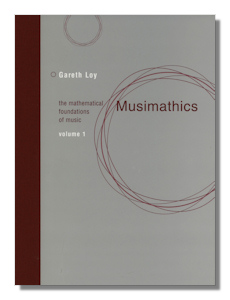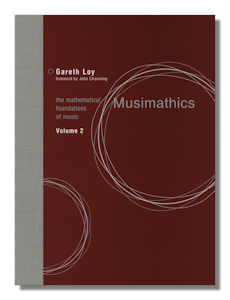
The Internet's Premier Classical Music Source
Related Links
-
Introduction
Acoustics
Ballet
Biographies
Chamber Music
Composers & Composition
Conducting
Criticism & Commentary
Discographies & CD Guides
Fiction
History
Humor
Illustrations & Photos
Instrumental
Lieder
Music Appreciation
Music Education
Music Industry
Music and the Mind
Opera
Orchestration
Reference Works
Scores
Thematic Indices
Theory & Analysis
Vocal Technique
Search Amazon
Recommended Links
Site News
 Book Review
Book Review
Musimathics

Volume 1
Gareth Loy
MIT Press, 2006, xviii + 482pp
ISBN-10: 0262122820
ISBN-13: 978-0262122825


Volume 2
Gareth Loy
MIT Press, 2007, xiv + 562 pp
ISBN-10: 0262122855
ISBN-13: 978-0262122856
Music and mathematics, of course, have much in common. Even to a casual listener, the extent to which the former relies on the latter is obvious – if not always clear: meter, rhythm, harmony, intervals, the way notation represents sound, tuning, temperament, scales, note divisions, and a variety of compositional techniques from basic proportion through the Fibonacci series to principles of aleatoric determination. And then the huge area of acoustics, the physics of sound and digital audio. But there are few books which deal specifically with the pure mathematics behind music. Fewer still that do it well; and are at the same time comprehensive and accessible, accurate and usable by the specialist and general listener, performer and composer. If you're looking for explanations of those mathematical foundations on which music exists, explanations which go beyond a perfunctory chapter or two – often based on "due diligence" as much as on a love or accomplished understanding of what can at times be a complex and confusing area – then put the two volumes from the Massachusetts Institute of Technology (MIT) Press with a title that hints at the conceptual fusion of the two disciplines, Musimathics, Volumes 1 & 2 at the top of your list.
Perhaps the first thing that strikes you about this excellent pair of books is the very reasonable price. Almost 1,000 pages of authoritative, relevant, well-organized and extremely useful musical and mathematical information, explanation and demonstration for well under US$100. Then, you'll be impressed by the easy yet knowledgeable style of Gareth Loy, the author. Completely in command of every last aspect of all the topics he surveys, Loy nevertheless manages to give the impression that he's exploring them with you, rather than for you. Not easy with some of the complex topics covered. He usually manages to introduce a topic with something new and interesting… the origins of the word, algebra [volume 2, page 513], for instance; why imaginary numbers are needed [volume 2, pages 49-51]; the exact reason for the Doppler effect [volume 1, page 228]; the very heading of the section which addresses temperament, "The Powers of the Fifth and the Octave Do Not Form a Closed System" [volume 1, page 66]. Yes, Loy's expositions are usually as clear as you can imagine. Yet never simplified, patronizing or diluted. Quite an achievement.
Next it's likely that you'll begin to appreciate the breadth of areas covered. From the following, it's clear that acoustics and sound management get the lion's share of these two books. The way in which musical notes themselves work – as mathematical constructs – is amply covered. But it's made sufficiently straight forward as to leave the bulk of the space to the physics and mathematics of sound production, use and behavior. Volume 1 is divided into nine major chapters with two appendices of 10 and 30 pages; a comprehensive glossary, chapter notes, references and an index. The ground covered in the body of the text includes: music and sound (about 3% of the substantive material); representing music (7%); scales, tuning, and intonation (14%); the physical basis of sound (8%); the geometrical basis of sound (5%); the psychophysical basis of sound (12%); introductory acoustics (10%); vibrating systems (11%); composition and methodology (30%). Volume 2 comprises 11 chapters and as many appendices (17 pages) with glossary, notes and index. The material addressed includes digital signals and sampling (about 9% of the substantive text); musical signals (7%); graphing complex signals (4%); spectral analysis and synthesis (11%); convolution (7%); filtering (13%); resonance (7%); the wave equation (5%); acoustical systems (7%); sound synthesis (17%); dynamic spectra (12%).
Having begun Musimathics and/or seen what's covered in the books, it may not be so obvious that you really need to work with both volumes. Begin with the first. Yet expect both that it's written in such a way as to introduce topics; and that the second volume will go into greater depth in areas like acoustics and the various methods of analyzing sound. It's also clear pretty much from the start that some background in mathematics and the understanding of formulae in particular is necessary in order to get the most from the book… as early as the second chapter in volume 1 the nature of frequency in explaining octaves can only really be treated using formulae. But immediately after the equation, Loy is there with "This equation says…" a full and clear explanation.
One of the book's, and Loy's, basic suppositions is that there is a cultural gap – one largely the fault of education systems – between appreciations of music and math and a good understanding of the roles of the one in the other. The music of mathematics is almost as important in Musimathics as is the mathematics of music. Amongst the implications of this is a love of "musical mathematics" almost for its own sake. Certainly as a discipline with its own logic, albeit one that serves the interests of music. But the best way to understand mathematics in music is really to understand the mathematics qua mathematics. Then it becomes clear why music behaves as it does. Just as Loy deals with, say, the physics of absorption in order to explain related behavior of sound [volume 1, pages 221-222], for example, so we can best understand some aspects of vibration [volume 1, chapter 8] by having recursion in our blood. General topics are explained in the Appendix, usually with simple, concrete examples such as that to illustrate modulo arithmetic [volume 2, page 522] and Xeno's Paradox [Volume 1, page 414].
It will be obvious by now that this is a book wholeheartedly to be recommended for a wide readership. As definitive as is possible, certainly the leading resource in the field, it will meet many needs. Those with school algebra and physics who are performers, engineers, composers, listeners will almost inevitably get much from Musimathics. It does strike a balance – between experience, and the need to make what might have been intimidating hitherto both understandable, and applicable in many a practical situation. And is does so without compromising the substance or import of the material that Loy covers. Apparently, he considered subtitling Musimathics, "Everything I wanted to know about music when I was eleven" – about music, note; not about "mathematics". This is indicative of the author's intention to expose and explain the otherwise perhaps confounding and over-specialized, or hidden principles underlying our art. With the true gifts of a wise and sensitive teacher, Loy succeeds on every count. Everything, every idea, process, reason, cause and concept is made clear and uncluttered. Then the relative weights of what matters to his audience, the relative importances of the subjects covered, are both apt and acceptable to all but the complete novice or advanced specialist.
Each chapter comes with suggested reading specific to the topics covered. The layout, typeface, amount of white space, standard of proof-reading and general sequencing, arrangement and division, cross-referencing and pacing are all excellent. Perhaps most significant for Classical Net music lovers is Loy's very human approach – for all that one of the book's appendices deals in just the right amount of detail with the musical programming language which he developed, MUSIMAT. Near the beginning of volume 1 [page xvii] is this quote from Jung:
The decisive question for man [sic] is: is he related to something infinite or not? In the final analysis, we count for something only because of the essential we embody, and if we do not embody, that, life is wasted.
followed by Loy's calm and helpful gloss, "In the storm called life, mathematics and music are two sure guides to that essential that we all embody." At the end of volume 2 he alludes to early inhabitants of the South Pacific islands navigating with their mathematics. This is but one topos of the inextinguishability of culture and cultural transmission. It behoves us to work with those forces, through a thorough understanding of the mathematics of music.
The two volumes of Musimathics, then, must be considered as the place to start any exploration of this field. Entertaining, secure, comprehensive, clear, authoritative, timely, up-to-date, well wrought in every way, these are for every music lover's shelves.
Copyright © 2011 by Mark Sealey.



















